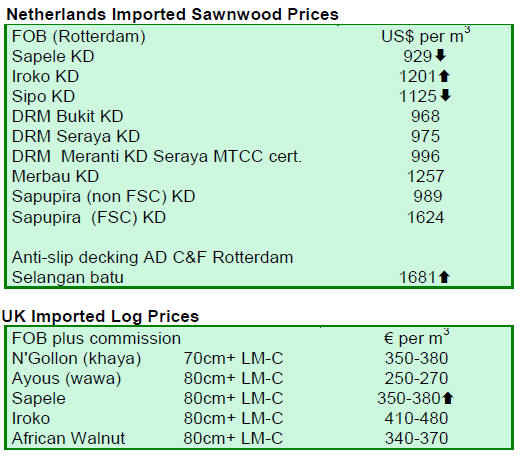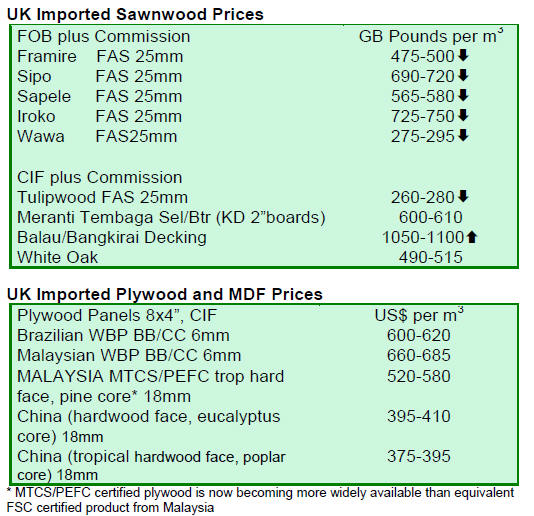|
Report
from
Europe
European market for tropical wood quiet but stable
The European market for tropical hardwood lumber is
quiet but stable. Uncertainty about future demand has
meant that forward purchasing is being kept to a
minimum.
Overall, European stocks of sawnwood of the most
popular species such as meranti, bankirai, sapele, sipo, and
wawa remain at historically low levels. However, with
slow consumption this has not led to reports of significant
supply problems. Orders are being placed to replace stocks
as and when gaps open up.
Long lead times for African sawnwood remain a problem
in the European market. Turnaround times for forward
orders are currently running at around three months for
sapele and significantly longer for other species.
As a result there is heavy reliance on cross trading with
other importers for many species. Accordingly, Meranti
sawnwood, which despite log procurement problems in
Malaysia, is still more readily available at shorter notice
and is gaining a marketing edge.
The supply situation in Ivory Coast still remains difficult
with the result that availability of framire/idigbo and iroko
is restricted. Gaboní»s log export ban which has yet to be
offset by sufficient development of domestic sawing
capacity has also resulted in limited supplies of a wide
range of more specialist species such as afzelia/doussie,
izombe, kevazingo/bubinga, and movingui.
Availability of Indonesian bangkirai decking profiles
improved slightly from earlier in the year. However the
existing landed stocks of bangkirai decking are generally
regarded as sufficient to meet relatively subdued demand
in the European market this year. This, combined with
high prices, is deterring any significant upturn in new
orders for bangkirai by European importers.
With only a few exceptions, prices on offer to European
buyers for the leading commercial species ĘC sapele, sipo,
iroko, framire, and meranti ĘC have remained relatively
stable in recent weeks.
The most notable exception is bangkirai decking, prices
for which have continued to escalate to levels that
importers say cannot be absorbed in Europe under current
market conditions. There are also reports of firming prices
in the European market for more specialist species
previously cut from logs imported from Gabon.
Consumption and exchange rate concerns dampen
forward business
A key factor discouraging speculative timber purchasing
by European importers is the high level of uncertainty over
future consumption levels and exchange rates trends.
Having started the year at around €1.28/USD, the euro
strengthened considerably to reach €1.48/USD in early
May. Since then the euro has lost only some of this
strength, falling to €1.38/USD by 10 July.
The strength of the euro has been maintained over recent
months by relatively high interest rates set by the
European Central Bank (ECB), by solid economic
performance in parts of north central Europe, particularly
Germany, and by Chinese investorsí» efforts to diversify
out of dollars in favour of euro assets.
However, concerns continue to mount over contagion
from the sovereign debt crises in Greece. Furthermore, in
the last few days ECB President Jean-Claude Trichet
observed that economic activity in the Eurozone appears
to be slowing.
Trichetí»s statement is backed by disappointing Italian
industrial production numbers as well as German trade
figures which show that Europeí»s largest economy is
becoming increasingly dependent on imports of finished
goods.
These factors have encouraged some analysts to predict
more substantial weakening of the euro against the dollar
and other international currencies over coming weeks.
From the perspective of the European hardwood industry,
weakening of the euro would have several benefits. It
would help boost competitiveness of Europeí»s furniture
manufacturers which have been struggling against the
pressure of imports. While a weaker euro would increase
import prices for raw material, it would also lead to
appreciation in the value of importers existing landed
stocks.
A weaker euro against the dollar also tends to improve the
relative competitiveness of African sawn lumber (typically
invoiced in euros) compared to South East Asian and
Brazilian sawn lumber (typically invoiced in dollars).
ThermoWood sales rebounded strongly in 2010
Production data published by the International
ThermoWood Association (ITWA) based in Finland gives
an insight into the recent development of Europeí»s thermal
treatment business.
Members of the Association are those companies using the
ThermoWood method developed in Finland and which
have the legal right to use the word ThermoWood onproduct
and in their marketing material.
The ThermoWood method greatly enhances the durability
and stability of softwoods and temperate hardwoods so
that they are capable of competing with tropical
hardwoods in certain end-use sectors including decking,
window frames, cladding and external doors. Of 13 ITWA
members, 10 are based in Finland and one each in
Sweden, Japan and Turkey.
According to ITWA, ThermoWood sales increased
continually between 2003 and 2008 to reach 79,000 cu.m
in 2008 before the onset of recession which led to a
decline in sales to 74,000 m3 in 2009 (see chart).
However sales rebounded strongly in 2010 to reach an all
time high of 92,000 cu.m. Around 91% of ThermoWood
production was based on pine and spruce in 2010, with
birch, aspen and ash accounting for much of the rest. Last
year, 87% of all Thermowood produced was sold inside
the EU.
Membership of ITWA does not include companies using
the expanding range of alternative heat and chemical
treatments to ThermoWood. A recent analysis by the
German trade journal EUWID identified a total of 30
companies across Europe operating various treatment
plants of this type with capacity of around 300,000 cu.m.
On this basis, members of the ITWA probably account for
between 30 and 40% of total capacity across Europe.
Other countries with significant capacity include Germany
(about 13% of total European capacity), Netherlands
(12%), and Estonia (8%). Other countries with treatment
plants include France, Croatia, Austria, and Switzerland.
European countries to negotiate a legally binding
forest agreement
European Ministers agreed to begin negotiations on a
legally binding agreement (LBA) for sustainable
management of Europe's forests. The announcement came
at the Ministerial Conference on the Protection of Forests
in Europe (or Forest Europe) held in Oslo, Norway from
14-16 June 2011.
The agreement would require all European countries to
develop and ensure implementation of a national
sustainable forest programme. This would integrate
climate adaptation and mitigation strategies with broader
sustainability goals such as biodiversity conservation and
rural development. Ministers also agreed at the meeting to
cut the rate of biodiversity loss within forest habitats by
half, and to take steps to eliminate illegal logging.
According to media reports, there was no universal
support for adopting an LBA amongst European countries.
Sweden's Rural Affairs Minister Eskil Erlandsson told the
conference that while he supported the concept of
sustainable forest management, he favoured a voluntary
approach rather than an LBA. "I do not believe in common
legislation for forests across the pan-European region.
Put simply, one size does not fit all," he said. "We need to
recognise the different geo-climatic and socio-economic
conditions. Therefore, my conclusion is that the voluntary
track is the best way of supporting the development and
implementation of sustainable forest management."
However, he said he signed the declaration in order for
negotiations to begin.
As background for the Forest Europe meeting, and to
provide a starting point for negotiation of an LBA, the UN
Economic Commission for Europe (UNECE), the UN
Food and Agriculture Organization (FAO) and Forest
Europe collaborated to produce "State of Europe's Forests
2011: Status and Trends in Sustainable Forest
Management in Europe". The report is based on detailed
information provided by countries.
The main findings of the report include that:
• forests cover one billion hectares in Europe, 80%
of which are in the Russian Federation; European
forests cover 45% of total land area, or 32% if
Russia is excluded;
• European forests are expanding at a rate of 0.8
million hectares every year and remove the
equivalent of about 10% of European greenhouse
gas (GHG) emissions; there is a high degree of
fragmentation with around 30 million private
owners;
• most Europeans think that their forests are
shrinking;
• the sector provides four million jobs and accounts
for 1% of the regioní»s GDP;
and
• most countries have explicit objectives on forestrelated
carbon.
Authors of the report developed a draft method to assess
European forestsí» sustainability, which while not yet peerreviewed,
identifies a number of threats and challenges,
including:
• landscape fragmentation;
• a shrinking and aging workforce;
• negative net revenues of several forest
enterprises;
and
• mobilizing enough wood for energy while
reconciling biodiversity values and the needs of
the traditional wood sectors.
The report is available at:
http://www.foresteurope.org/?module=Files;action=File.g
etFile;ID=1630
New guide to legal and sustainable forest and trade initiatives
A new guide to global initiatives designed to promote
legal and sustainable timber production and trade has been
published by Tropenbos International with support from
the Ministry of Economic Affairs, Agriculture and
Innovation of the Netherlands.
The guide describes a total of 127 government, privatesector
and NGO initiatives towards enhancing
understanding and support for the exchange of views and
proposals on efforts to advance forest governance and
encourage legal and sustainable forest industries and trade.
The guide suggests that "the range of initiatives reflects
the increasing commitment from a large variety of
stakeholders who are willing to address illegality in the
forest sector í¬ substantial momentum has been created".
While recognising the benefits from such a diversity of
initiatives, the guide also points to the dangers: "the
growing number... of initiatives....may make
communication, cooperation and coordination challenging.
Initiatives should avoid duplication and ensure consistency
in issues such as transparency, inclusiveness, market
pricing, equality, synergies and effectiveness, both in
policy development and in implementation."
It also notes that there are gaps in the frameworks and that
"still, some countries and regions either have limited or no
initiatives".
The guide recommends that "various areas should be
further explored for their potential to expand the scope and
effectiveness of efforts to halt illegal timber production
and trade.
Examples include timber procurement initiatives and
codes of conduct by the public and private sector,
incorporating effective forest governance and promotion
of legal and sustainable timber production and trade in
bilateral cooperation initiatives".
The guide is available at:
http://illegallogging.
info/uploads/enhancingtradelegallytimberweb.pdf

 Related News:
íí
|